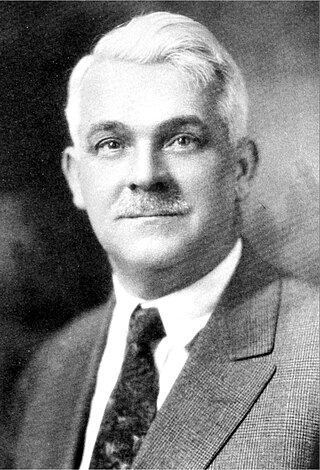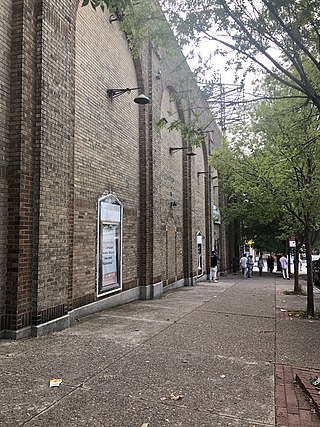Related Research Articles
Charles Zeller Klauder was an American architect best known for his work on university buildings and campus designs, especially his Cathedral of Learning at the University of Pittsburgh, the first educational skyscraper.

Thomas White Lamb was a Scottish-born, American architect. He was one of the foremost designers of theaters and cinemas of the 20th century.

The Benedum Center for the Performing Arts is a theater and concert hall located at 237 7th Street in the Cultural District of Pittsburgh, Pennsylvania. Designed by the Philadelphia architectural firm Hoffman-Henon, it was built in 1928 as the Stanley Theatre. The former movie palace was renovated and reopened as the Benedum Center for the Performing Arts in 1987.

Warren and Wetmore was an architecture firm based in New York City, a partnership established about 1889 by Whitney Warren (1864–1943) and Charles D. Wetmore (1866–1941). They had one of the most extensive practices of their time, and were especially known for having designed many large hotels.
The Cultural District is a fourteen-square-block area in Downtown Pittsburgh bordered by the Allegheny River on the north, Tenth Street on the east, Stanwix Street on the west, and Liberty Avenue on the south.

Horace Trumbauer was a prominent American architect of the Gilded Age, known for designing residential manors for the wealthy. Later in his career he also designed hotels, office buildings, and much of the campus of Duke University.

Boller Brothers, often written Boller Bros., was an architectural firm based in Kansas City, Missouri which specialized in theater design in the Midwestern United States during the first half of the 20th century. Carl Heinrich Boller (1868–1946) and Robert Otto Boller (1887–1962) are credited with the design of almost 100 classic theaters ranging from small vaudeville venues to grand movie palaces.

John Adolph Emil Eberson was an Austrian-American architect best known for the development and promotion of movie palace designs in the atmospheric theatre style. He designed over 500 theatres in his lifetime, earning the nickname "Opera House John". His most notable surviving theatres in the United States include the Tampa Theatre (1926), Palace Theatre Marion (1928), Palace Theatre Louisville (1928), Majestic Theatre (1929), Akron Civic Theatre (1929), the Paramount Theatre (1929), the State Theater 1927, and the Lewis J. Warner Memorial Theater (1932) at Worcester Academy in Worcester, Massachusetts. Remaining international examples in the atmospheric style include both the Capitol Theatre (1928) and State Theatre (1929) in Sydney, Australia, The Forum and Le Grand Rex.
West Philadelphia Catholic High School for Boys was founded in 1916. A school building was later constructed at 49th Street between Chestnut and Market Streets in Philadelphia, Pennsylvania. The school closed its doors in 1989 when the co-educational West Philadelphia Catholic High School opened in the former West Philadelphia Catholic Girls High School building at 45th and Chestnut Street.
The Boyd Theatre was a 1920s era movie palace in Center City Philadelphia, Pennsylvania. It operated as a movie theater for 74 years, operating under the name Sameric as part of the United Artists theater chain, before closing in 2002. The theater was the last of its kind in downtown Philadelphia, a remnant of an era of theaters and movie palaces that stretched along Market and Chestnut Streets. The Boyd's auditorium was demolished in the 2015 by its owner Pearl Properties, which planned to replace it with a 24-story residential tower.
The Wynne Theater was a movie theater that was located on 54th and Wynnefield Avenue in the Wynnefield neighborhood of Philadelphia, Pennsylvania, United States.
The Erlanger Theatre was a live-performance theater at the northwest corner of 21st and Market Streets in Philadelphia, Pennsylvania. It was built in 1927 by Abraham L. Erlanger, theatrical producer and a founding member of the Theatrical Syndicate. It was demolished in 1978.
Louis Magaziner was the senior partner of a series of architectural firms based in Philadelphia, Pennsylvania. Born in Hungary, he came to the U.S. with his parents and graduated from the University of Pennsylvania as an architect in 1900.

Bala Theatre is a historic 1926 theater building at 157 Bala Avenue in Bala Cynwyd, Pennsylvania. It was designed by Philadelphia architectural firm Hoffman-Henon. The 1,450-seat theater opened as an Egyptian Theatre on September 15, 1926. It features Egyptian Revival architecture stylings.

Jules Ephraim Mastbaum was a Philadelphia movie theater magnate and philanthropist. He donated the Rodin Museum and its collection to the city of Philadelphia. His daughter, Peggy Solomon, was a bridge champion.

Allen Evans was an American architect and partner in the Philadelphia firm of Furness & Evans. His best known work may be the Merion Cricket Club.
Etta Wedell Mastbaum was an American philanthropist, department store executive, art collector, and director of a national chain of motion picture theaters.

Masjid Al-Jamia is a Sunni mosque in West Philadelphia. It was founded in 1988 by members of the Muslim Students Association at the University of Pennsylvania . Eight years later, the mosque became independent from the Penn MSA and, around 2009, acquired ownership of the building. Located at 4228 Walnut Street, in a historic building formerly occupied by the Commodore Theatre, the mosque currently serves a large and diverse Muslim population in the neighborhood. The mosque's name itself signals its importance to the community, as the Arabic etymology suggests. In Arabic, Masjid Al-Jamia means “the congregational mosque”, typically where Muslims meet for Friday prayers.
Alfred W. Fleisher was an American real estate investor and philanthropist. He was the co-founder and head of Mastbaum Brothers & Fleisher, and the president of the board of trustees of the Eastern State Penitentiary. He supported prison reform.
References
- ↑ Cinema Treasures
- 1 2 3 4 Historic Theaters of Philadelphia
- ↑ "Commodore Theatre in Philadelphia, PA - Cinema Treasures". cinematreasures.org. Retrieved 2019-10-02.
- ↑ George D. McDowell Philadelphia Evening Bulletin Collection, Temple University Libraries, Urban Archives (June 2, 1964). """The Commodore Theatre, Seen from the West" photographed by Bob Williams"". Temple Digital Collections. Retrieved October 1, 2019.
{{cite web}}: CS1 maint: multiple names: authors list (link) - ↑ "Bolivar Theater".
- ↑ "Theater History | The Prince Music Theater". princemusictheater.org. Archived from the original on 2012-05-26.